Logistics Industry Report: Export Plan and Challenges
VerifiedAdded on 2022/09/22
|11
|2089
|25
Report
AI Summary
This report provides an in-depth analysis of the Australian logistics industry, highlighting its significant contribution to the GDP and employment. It explores the challenges faced in freight exportation, particularly in the context of trade with China, including bureaucratic hurdles, payment methods, language barriers, and financing issues. The report details the steps involved in freighting various types of cargo, from order placement to import clearance, and examines how a company approaches actors within the logistics network. It also discusses the process of freighting from a logistics network perspective and concludes with recommendations for improvement. Appendices include data on Australia's national logistics costs, and the report is well-supported by references to relevant academic literature.

LOGISTICS INDUSTRY 1
LOGISTICS INDUSTRY
Name
Institution
Professor
Course
Date
LOGISTICS INDUSTRY
Name
Institution
Professor
Course
Date
Paraphrase This Document
Need a fresh take? Get an instant paraphrase of this document with our AI Paraphraser
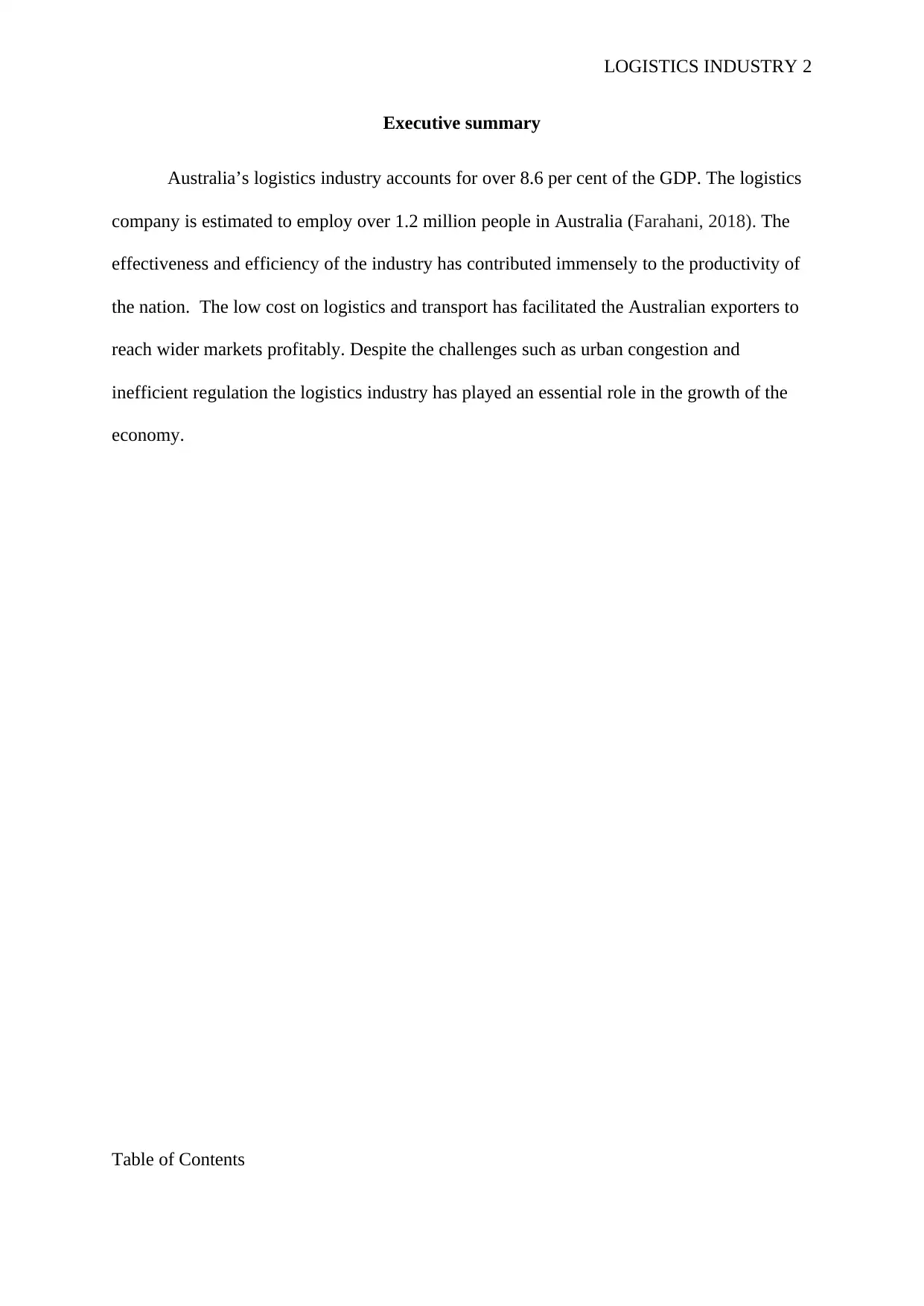
LOGISTICS INDUSTRY 2
Executive summary
Australia’s logistics industry accounts for over 8.6 per cent of the GDP. The logistics
company is estimated to employ over 1.2 million people in Australia (Farahani, 2018). The
effectiveness and efficiency of the industry has contributed immensely to the productivity of
the nation. The low cost on logistics and transport has facilitated the Australian exporters to
reach wider markets profitably. Despite the challenges such as urban congestion and
inefficient regulation the logistics industry has played an essential role in the growth of the
economy.
Table of Contents
Executive summary
Australia’s logistics industry accounts for over 8.6 per cent of the GDP. The logistics
company is estimated to employ over 1.2 million people in Australia (Farahani, 2018). The
effectiveness and efficiency of the industry has contributed immensely to the productivity of
the nation. The low cost on logistics and transport has facilitated the Australian exporters to
reach wider markets profitably. Despite the challenges such as urban congestion and
inefficient regulation the logistics industry has played an essential role in the growth of the
economy.
Table of Contents
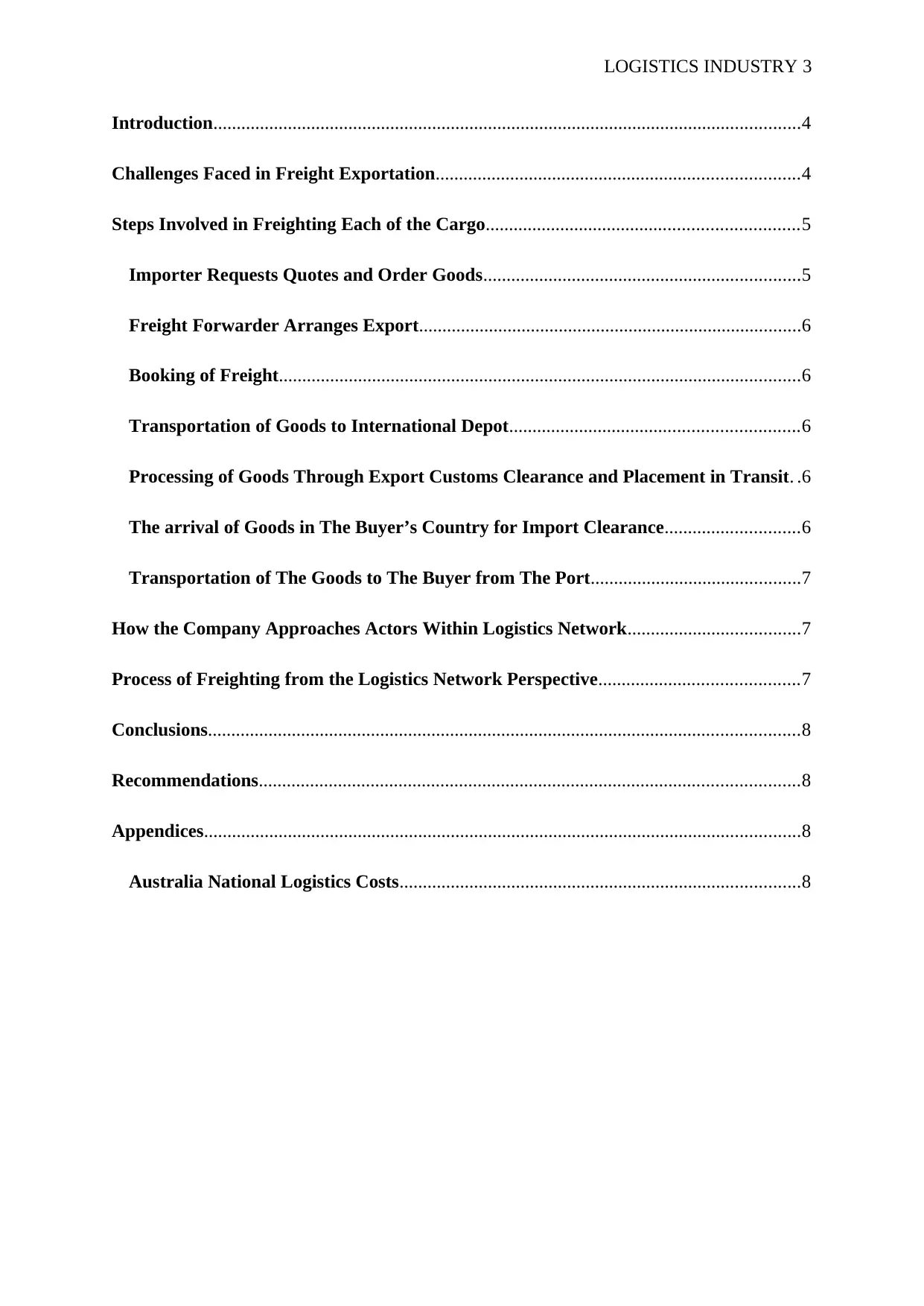
LOGISTICS INDUSTRY 3
Introduction..............................................................................................................................4
Challenges Faced in Freight Exportation..............................................................................4
Steps Involved in Freighting Each of the Cargo...................................................................5
Importer Requests Quotes and Order Goods....................................................................5
Freight Forwarder Arranges Export..................................................................................6
Booking of Freight................................................................................................................6
Transportation of Goods to International Depot..............................................................6
Processing of Goods Through Export Customs Clearance and Placement in Transit. .6
The arrival of Goods in The Buyer’s Country for Import Clearance.............................6
Transportation of The Goods to The Buyer from The Port.............................................7
How the Company Approaches Actors Within Logistics Network.....................................7
Process of Freighting from the Logistics Network Perspective...........................................7
Conclusions...............................................................................................................................8
Recommendations....................................................................................................................8
Appendices................................................................................................................................8
Australia National Logistics Costs......................................................................................8
Introduction..............................................................................................................................4
Challenges Faced in Freight Exportation..............................................................................4
Steps Involved in Freighting Each of the Cargo...................................................................5
Importer Requests Quotes and Order Goods....................................................................5
Freight Forwarder Arranges Export..................................................................................6
Booking of Freight................................................................................................................6
Transportation of Goods to International Depot..............................................................6
Processing of Goods Through Export Customs Clearance and Placement in Transit. .6
The arrival of Goods in The Buyer’s Country for Import Clearance.............................6
Transportation of The Goods to The Buyer from The Port.............................................7
How the Company Approaches Actors Within Logistics Network.....................................7
Process of Freighting from the Logistics Network Perspective...........................................7
Conclusions...............................................................................................................................8
Recommendations....................................................................................................................8
Appendices................................................................................................................................8
Australia National Logistics Costs......................................................................................8
⊘ This is a preview!⊘
Do you want full access?
Subscribe today to unlock all pages.

Trusted by 1+ million students worldwide
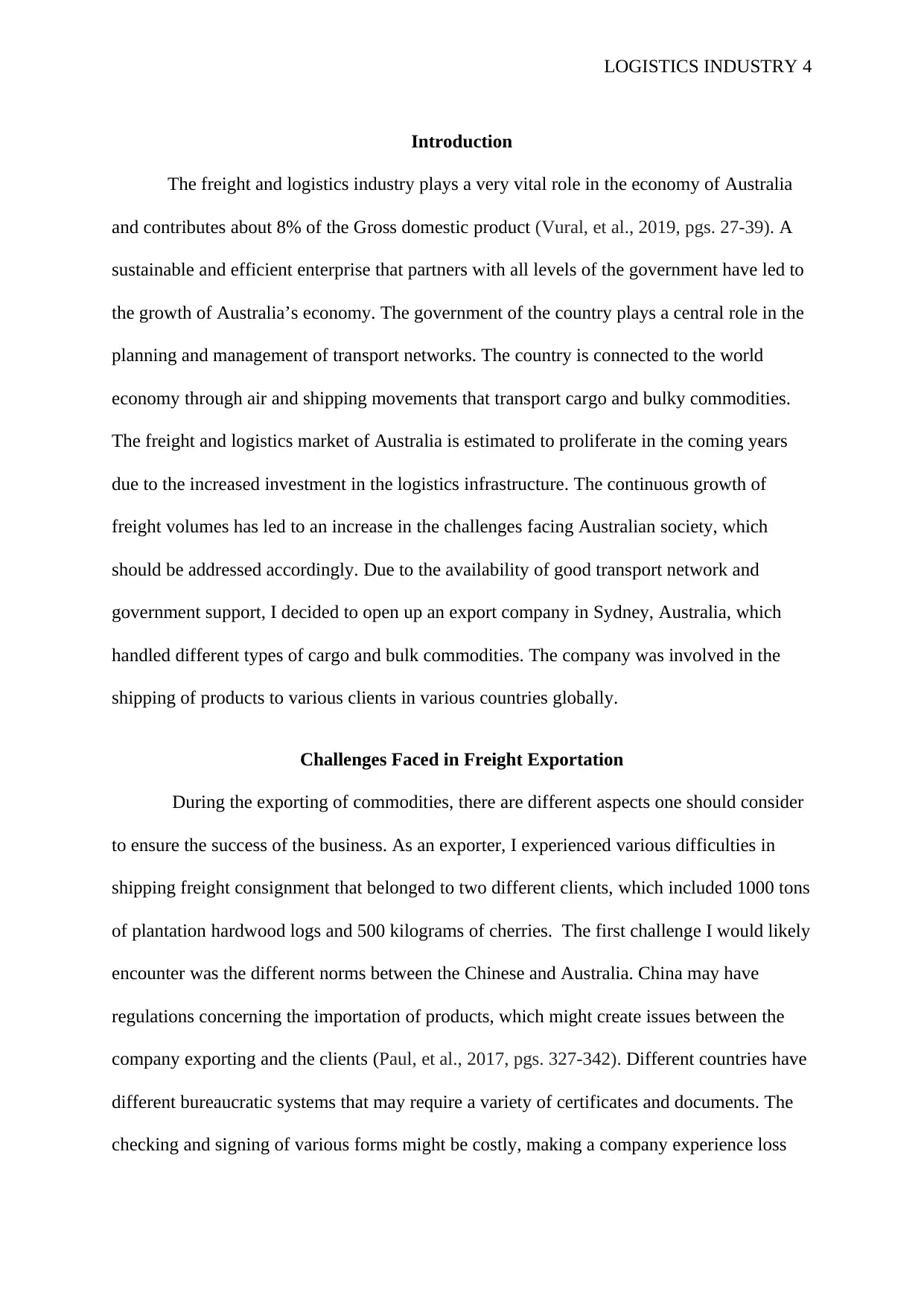
LOGISTICS INDUSTRY 4
Introduction
The freight and logistics industry plays a very vital role in the economy of Australia
and contributes about 8% of the Gross domestic product (Vural, et al., 2019, pgs. 27-39). A
sustainable and efficient enterprise that partners with all levels of the government have led to
the growth of Australia’s economy. The government of the country plays a central role in the
planning and management of transport networks. The country is connected to the world
economy through air and shipping movements that transport cargo and bulky commodities.
The freight and logistics market of Australia is estimated to proliferate in the coming years
due to the increased investment in the logistics infrastructure. The continuous growth of
freight volumes has led to an increase in the challenges facing Australian society, which
should be addressed accordingly. Due to the availability of good transport network and
government support, I decided to open up an export company in Sydney, Australia, which
handled different types of cargo and bulk commodities. The company was involved in the
shipping of products to various clients in various countries globally.
Challenges Faced in Freight Exportation
During the exporting of commodities, there are different aspects one should consider
to ensure the success of the business. As an exporter, I experienced various difficulties in
shipping freight consignment that belonged to two different clients, which included 1000 tons
of plantation hardwood logs and 500 kilograms of cherries. The first challenge I would likely
encounter was the different norms between the Chinese and Australia. China may have
regulations concerning the importation of products, which might create issues between the
company exporting and the clients (Paul, et al., 2017, pgs. 327-342). Different countries have
different bureaucratic systems that may require a variety of certificates and documents. The
checking and signing of various forms might be costly, making a company experience loss
Introduction
The freight and logistics industry plays a very vital role in the economy of Australia
and contributes about 8% of the Gross domestic product (Vural, et al., 2019, pgs. 27-39). A
sustainable and efficient enterprise that partners with all levels of the government have led to
the growth of Australia’s economy. The government of the country plays a central role in the
planning and management of transport networks. The country is connected to the world
economy through air and shipping movements that transport cargo and bulky commodities.
The freight and logistics market of Australia is estimated to proliferate in the coming years
due to the increased investment in the logistics infrastructure. The continuous growth of
freight volumes has led to an increase in the challenges facing Australian society, which
should be addressed accordingly. Due to the availability of good transport network and
government support, I decided to open up an export company in Sydney, Australia, which
handled different types of cargo and bulk commodities. The company was involved in the
shipping of products to various clients in various countries globally.
Challenges Faced in Freight Exportation
During the exporting of commodities, there are different aspects one should consider
to ensure the success of the business. As an exporter, I experienced various difficulties in
shipping freight consignment that belonged to two different clients, which included 1000 tons
of plantation hardwood logs and 500 kilograms of cherries. The first challenge I would likely
encounter was the different norms between the Chinese and Australia. China may have
regulations concerning the importation of products, which might create issues between the
company exporting and the clients (Paul, et al., 2017, pgs. 327-342). Different countries have
different bureaucratic systems that may require a variety of certificates and documents. The
checking and signing of various forms might be costly, making a company experience loss
Paraphrase This Document
Need a fresh take? Get an instant paraphrase of this document with our AI Paraphraser
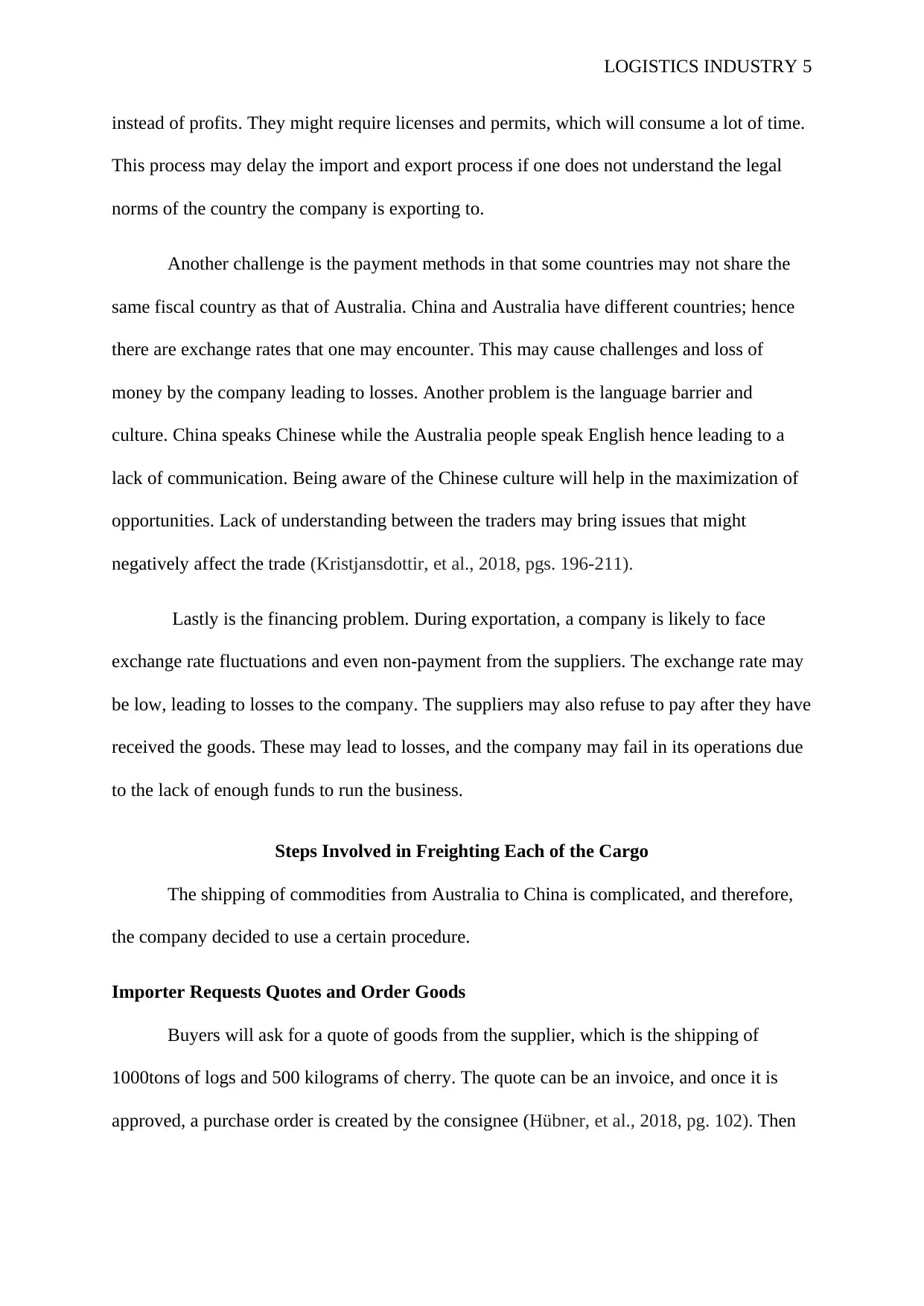
LOGISTICS INDUSTRY 5
instead of profits. They might require licenses and permits, which will consume a lot of time.
This process may delay the import and export process if one does not understand the legal
norms of the country the company is exporting to.
Another challenge is the payment methods in that some countries may not share the
same fiscal country as that of Australia. China and Australia have different countries; hence
there are exchange rates that one may encounter. This may cause challenges and loss of
money by the company leading to losses. Another problem is the language barrier and
culture. China speaks Chinese while the Australia people speak English hence leading to a
lack of communication. Being aware of the Chinese culture will help in the maximization of
opportunities. Lack of understanding between the traders may bring issues that might
negatively affect the trade (Kristjansdottir, et al., 2018, pgs. 196-211).
Lastly is the financing problem. During exportation, a company is likely to face
exchange rate fluctuations and even non-payment from the suppliers. The exchange rate may
be low, leading to losses to the company. The suppliers may also refuse to pay after they have
received the goods. These may lead to losses, and the company may fail in its operations due
to the lack of enough funds to run the business.
Steps Involved in Freighting Each of the Cargo
The shipping of commodities from Australia to China is complicated, and therefore,
the company decided to use a certain procedure.
Importer Requests Quotes and Order Goods
Buyers will ask for a quote of goods from the supplier, which is the shipping of
1000tons of logs and 500 kilograms of cherry. The quote can be an invoice, and once it is
approved, a purchase order is created by the consignee (Hübner, et al., 2018, pg. 102). Then
instead of profits. They might require licenses and permits, which will consume a lot of time.
This process may delay the import and export process if one does not understand the legal
norms of the country the company is exporting to.
Another challenge is the payment methods in that some countries may not share the
same fiscal country as that of Australia. China and Australia have different countries; hence
there are exchange rates that one may encounter. This may cause challenges and loss of
money by the company leading to losses. Another problem is the language barrier and
culture. China speaks Chinese while the Australia people speak English hence leading to a
lack of communication. Being aware of the Chinese culture will help in the maximization of
opportunities. Lack of understanding between the traders may bring issues that might
negatively affect the trade (Kristjansdottir, et al., 2018, pgs. 196-211).
Lastly is the financing problem. During exportation, a company is likely to face
exchange rate fluctuations and even non-payment from the suppliers. The exchange rate may
be low, leading to losses to the company. The suppliers may also refuse to pay after they have
received the goods. These may lead to losses, and the company may fail in its operations due
to the lack of enough funds to run the business.
Steps Involved in Freighting Each of the Cargo
The shipping of commodities from Australia to China is complicated, and therefore,
the company decided to use a certain procedure.
Importer Requests Quotes and Order Goods
Buyers will ask for a quote of goods from the supplier, which is the shipping of
1000tons of logs and 500 kilograms of cherry. The quote can be an invoice, and once it is
approved, a purchase order is created by the consignee (Hübner, et al., 2018, pg. 102). Then
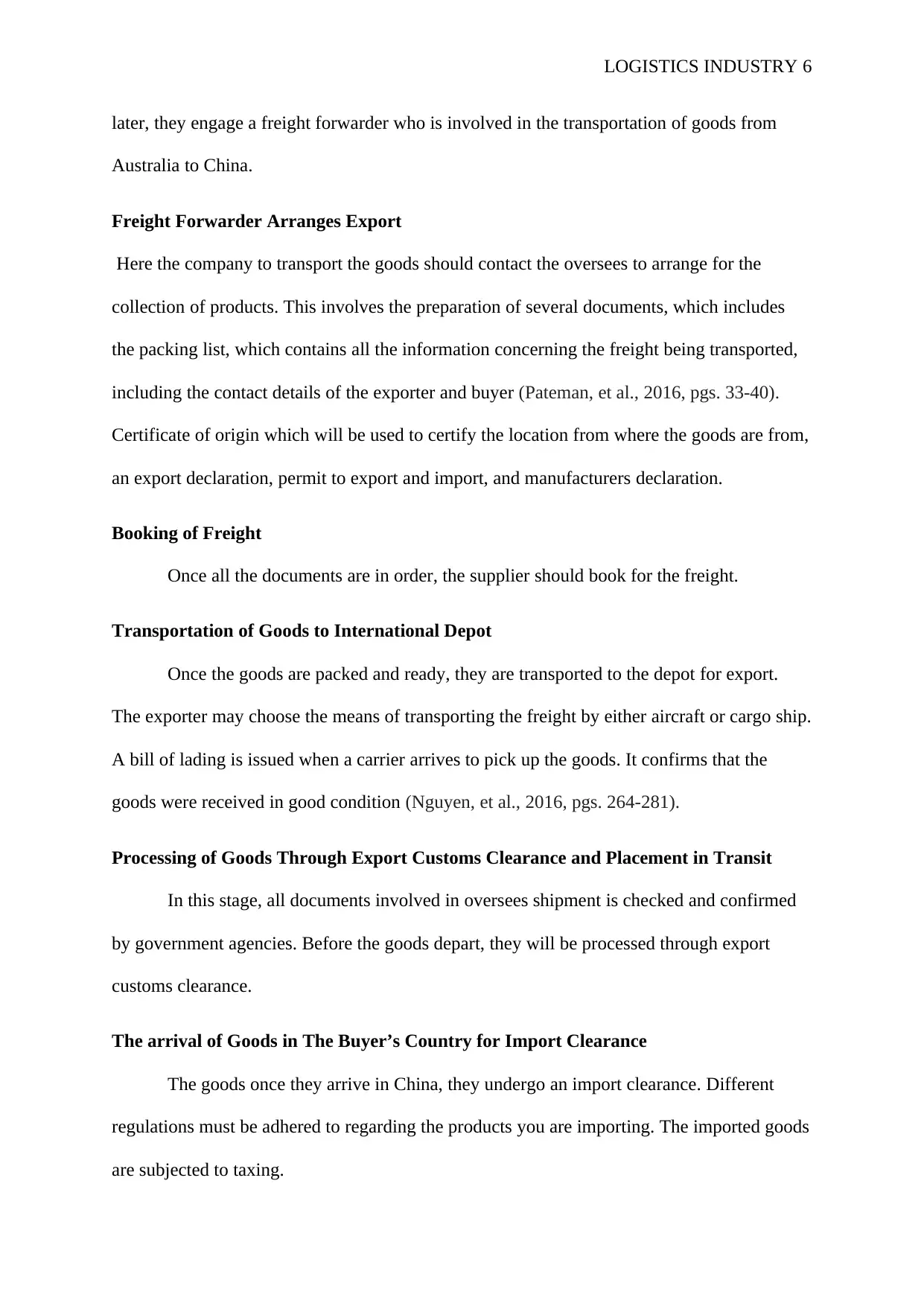
LOGISTICS INDUSTRY 6
later, they engage a freight forwarder who is involved in the transportation of goods from
Australia to China.
Freight Forwarder Arranges Export
Here the company to transport the goods should contact the oversees to arrange for the
collection of products. This involves the preparation of several documents, which includes
the packing list, which contains all the information concerning the freight being transported,
including the contact details of the exporter and buyer (Pateman, et al., 2016, pgs. 33-40).
Certificate of origin which will be used to certify the location from where the goods are from,
an export declaration, permit to export and import, and manufacturers declaration.
Booking of Freight
Once all the documents are in order, the supplier should book for the freight.
Transportation of Goods to International Depot
Once the goods are packed and ready, they are transported to the depot for export.
The exporter may choose the means of transporting the freight by either aircraft or cargo ship.
A bill of lading is issued when a carrier arrives to pick up the goods. It confirms that the
goods were received in good condition (Nguyen, et al., 2016, pgs. 264-281).
Processing of Goods Through Export Customs Clearance and Placement in Transit
In this stage, all documents involved in oversees shipment is checked and confirmed
by government agencies. Before the goods depart, they will be processed through export
customs clearance.
The arrival of Goods in The Buyer’s Country for Import Clearance
The goods once they arrive in China, they undergo an import clearance. Different
regulations must be adhered to regarding the products you are importing. The imported goods
are subjected to taxing.
later, they engage a freight forwarder who is involved in the transportation of goods from
Australia to China.
Freight Forwarder Arranges Export
Here the company to transport the goods should contact the oversees to arrange for the
collection of products. This involves the preparation of several documents, which includes
the packing list, which contains all the information concerning the freight being transported,
including the contact details of the exporter and buyer (Pateman, et al., 2016, pgs. 33-40).
Certificate of origin which will be used to certify the location from where the goods are from,
an export declaration, permit to export and import, and manufacturers declaration.
Booking of Freight
Once all the documents are in order, the supplier should book for the freight.
Transportation of Goods to International Depot
Once the goods are packed and ready, they are transported to the depot for export.
The exporter may choose the means of transporting the freight by either aircraft or cargo ship.
A bill of lading is issued when a carrier arrives to pick up the goods. It confirms that the
goods were received in good condition (Nguyen, et al., 2016, pgs. 264-281).
Processing of Goods Through Export Customs Clearance and Placement in Transit
In this stage, all documents involved in oversees shipment is checked and confirmed
by government agencies. Before the goods depart, they will be processed through export
customs clearance.
The arrival of Goods in The Buyer’s Country for Import Clearance
The goods once they arrive in China, they undergo an import clearance. Different
regulations must be adhered to regarding the products you are importing. The imported goods
are subjected to taxing.
⊘ This is a preview!⊘
Do you want full access?
Subscribe today to unlock all pages.

Trusted by 1+ million students worldwide
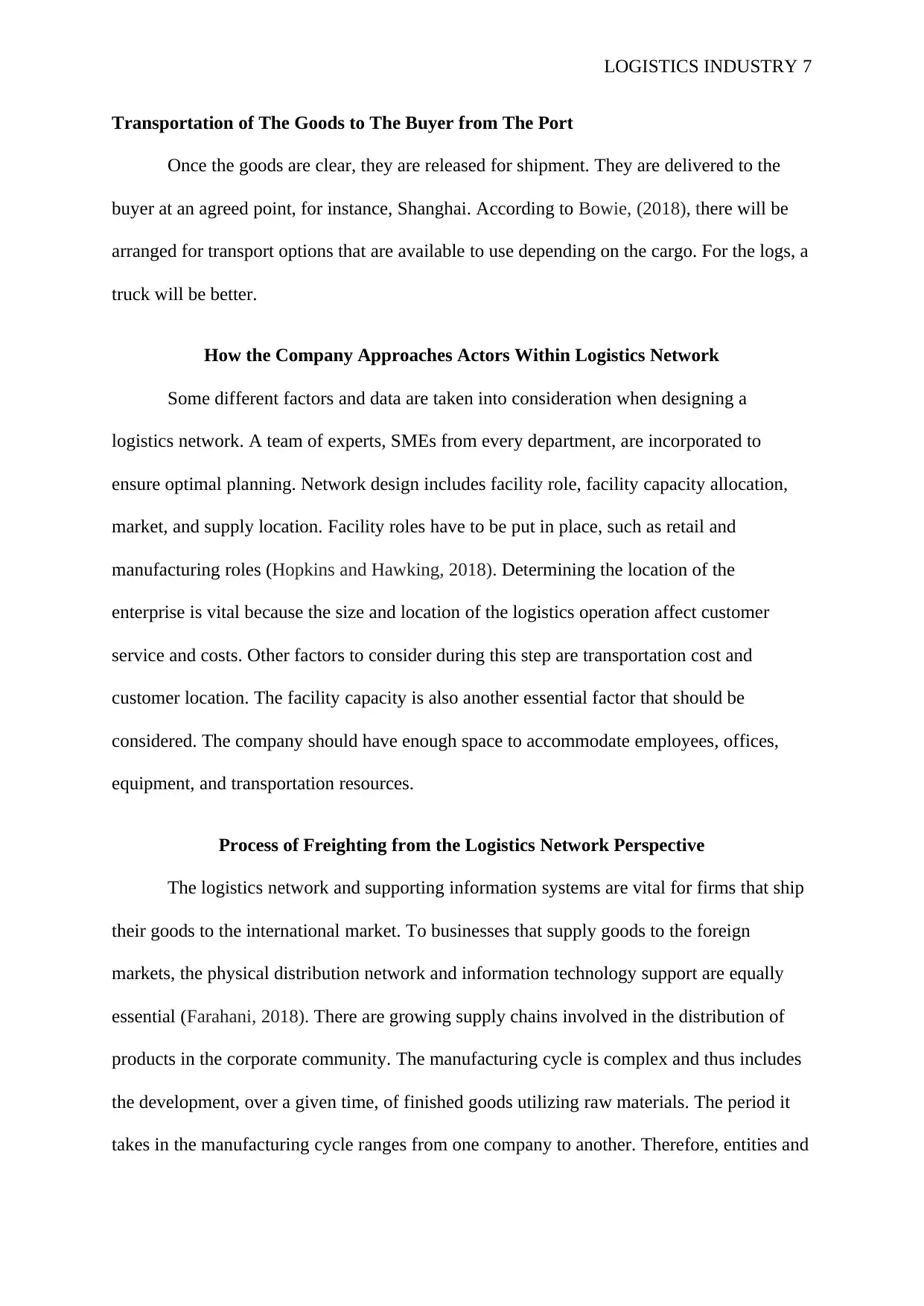
LOGISTICS INDUSTRY 7
Transportation of The Goods to The Buyer from The Port
Once the goods are clear, they are released for shipment. They are delivered to the
buyer at an agreed point, for instance, Shanghai. According to Bowie, (2018), there will be
arranged for transport options that are available to use depending on the cargo. For the logs, a
truck will be better.
How the Company Approaches Actors Within Logistics Network
Some different factors and data are taken into consideration when designing a
logistics network. A team of experts, SMEs from every department, are incorporated to
ensure optimal planning. Network design includes facility role, facility capacity allocation,
market, and supply location. Facility roles have to be put in place, such as retail and
manufacturing roles (Hopkins and Hawking, 2018). Determining the location of the
enterprise is vital because the size and location of the logistics operation affect customer
service and costs. Other factors to consider during this step are transportation cost and
customer location. The facility capacity is also another essential factor that should be
considered. The company should have enough space to accommodate employees, offices,
equipment, and transportation resources.
Process of Freighting from the Logistics Network Perspective
The logistics network and supporting information systems are vital for firms that ship
their goods to the international market. To businesses that supply goods to the foreign
markets, the physical distribution network and information technology support are equally
essential (Farahani, 2018). There are growing supply chains involved in the distribution of
products in the corporate community. The manufacturing cycle is complex and thus includes
the development, over a given time, of finished goods utilizing raw materials. The period it
takes in the manufacturing cycle ranges from one company to another. Therefore, entities and
Transportation of The Goods to The Buyer from The Port
Once the goods are clear, they are released for shipment. They are delivered to the
buyer at an agreed point, for instance, Shanghai. According to Bowie, (2018), there will be
arranged for transport options that are available to use depending on the cargo. For the logs, a
truck will be better.
How the Company Approaches Actors Within Logistics Network
Some different factors and data are taken into consideration when designing a
logistics network. A team of experts, SMEs from every department, are incorporated to
ensure optimal planning. Network design includes facility role, facility capacity allocation,
market, and supply location. Facility roles have to be put in place, such as retail and
manufacturing roles (Hopkins and Hawking, 2018). Determining the location of the
enterprise is vital because the size and location of the logistics operation affect customer
service and costs. Other factors to consider during this step are transportation cost and
customer location. The facility capacity is also another essential factor that should be
considered. The company should have enough space to accommodate employees, offices,
equipment, and transportation resources.
Process of Freighting from the Logistics Network Perspective
The logistics network and supporting information systems are vital for firms that ship
their goods to the international market. To businesses that supply goods to the foreign
markets, the physical distribution network and information technology support are equally
essential (Farahani, 2018). There are growing supply chains involved in the distribution of
products in the corporate community. The manufacturing cycle is complex and thus includes
the development, over a given time, of finished goods utilizing raw materials. The period it
takes in the manufacturing cycle ranges from one company to another. Therefore, entities and
Paraphrase This Document
Need a fresh take? Get an instant paraphrase of this document with our AI Paraphraser
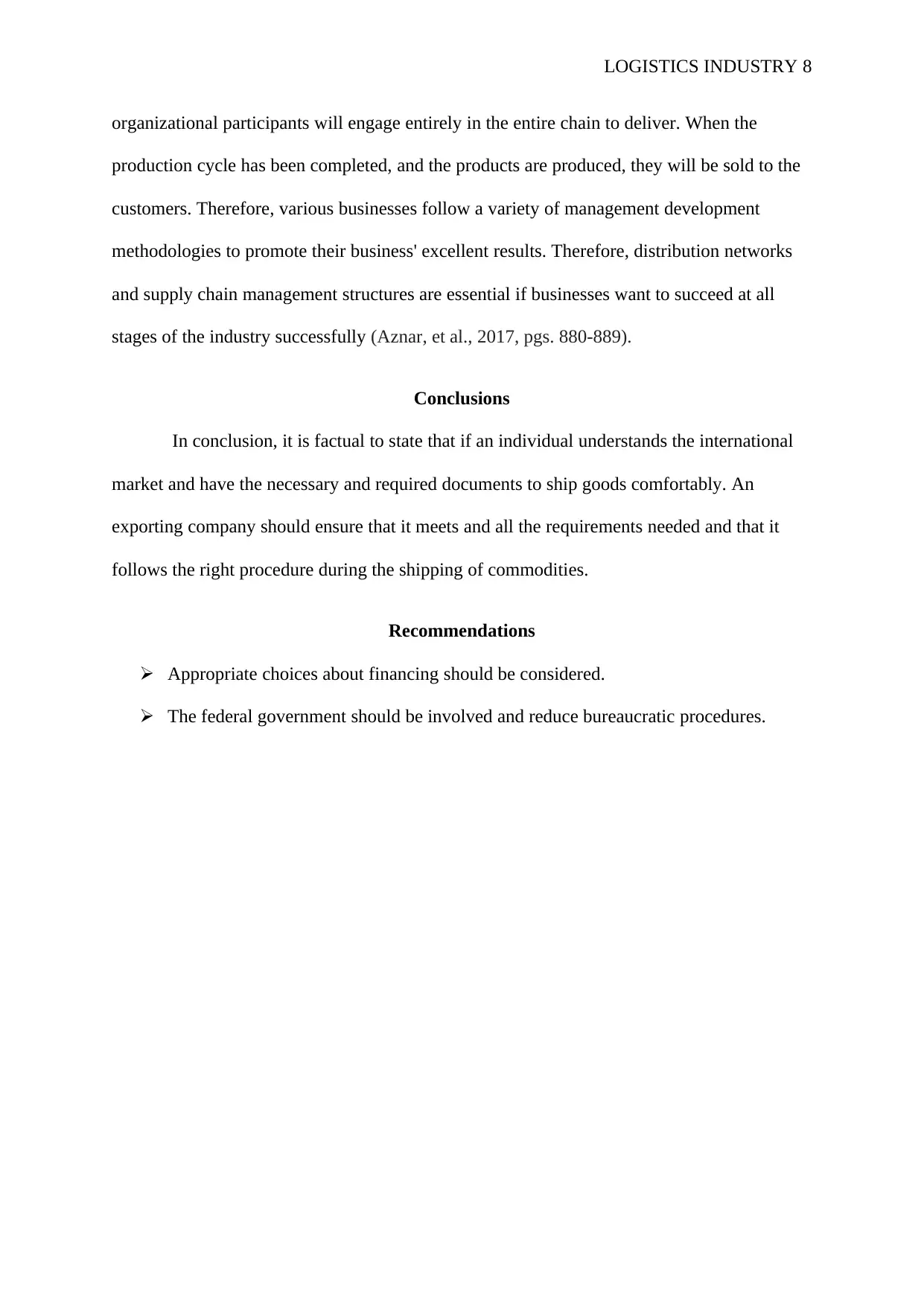
LOGISTICS INDUSTRY 8
organizational participants will engage entirely in the entire chain to deliver. When the
production cycle has been completed, and the products are produced, they will be sold to the
customers. Therefore, various businesses follow a variety of management development
methodologies to promote their business' excellent results. Therefore, distribution networks
and supply chain management structures are essential if businesses want to succeed at all
stages of the industry successfully (Aznar, et al., 2017, pgs. 880-889).
Conclusions
In conclusion, it is factual to state that if an individual understands the international
market and have the necessary and required documents to ship goods comfortably. An
exporting company should ensure that it meets and all the requirements needed and that it
follows the right procedure during the shipping of commodities.
Recommendations
Appropriate choices about financing should be considered.
The federal government should be involved and reduce bureaucratic procedures.
organizational participants will engage entirely in the entire chain to deliver. When the
production cycle has been completed, and the products are produced, they will be sold to the
customers. Therefore, various businesses follow a variety of management development
methodologies to promote their business' excellent results. Therefore, distribution networks
and supply chain management structures are essential if businesses want to succeed at all
stages of the industry successfully (Aznar, et al., 2017, pgs. 880-889).
Conclusions
In conclusion, it is factual to state that if an individual understands the international
market and have the necessary and required documents to ship goods comfortably. An
exporting company should ensure that it meets and all the requirements needed and that it
follows the right procedure during the shipping of commodities.
Recommendations
Appropriate choices about financing should be considered.
The federal government should be involved and reduce bureaucratic procedures.
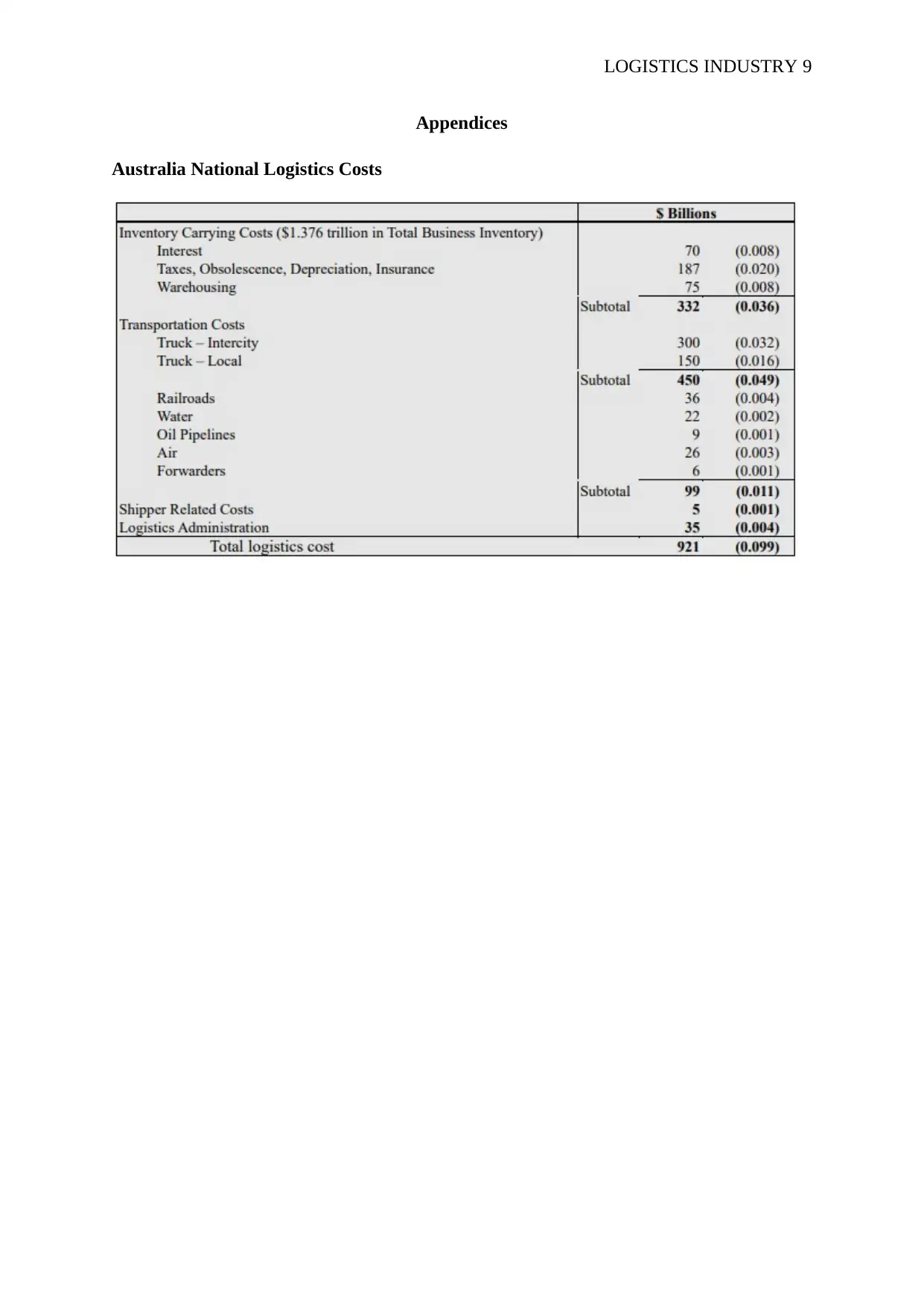
LOGISTICS INDUSTRY 9
Appendices
Australia National Logistics Costs
Appendices
Australia National Logistics Costs
⊘ This is a preview!⊘
Do you want full access?
Subscribe today to unlock all pages.

Trusted by 1+ million students worldwide
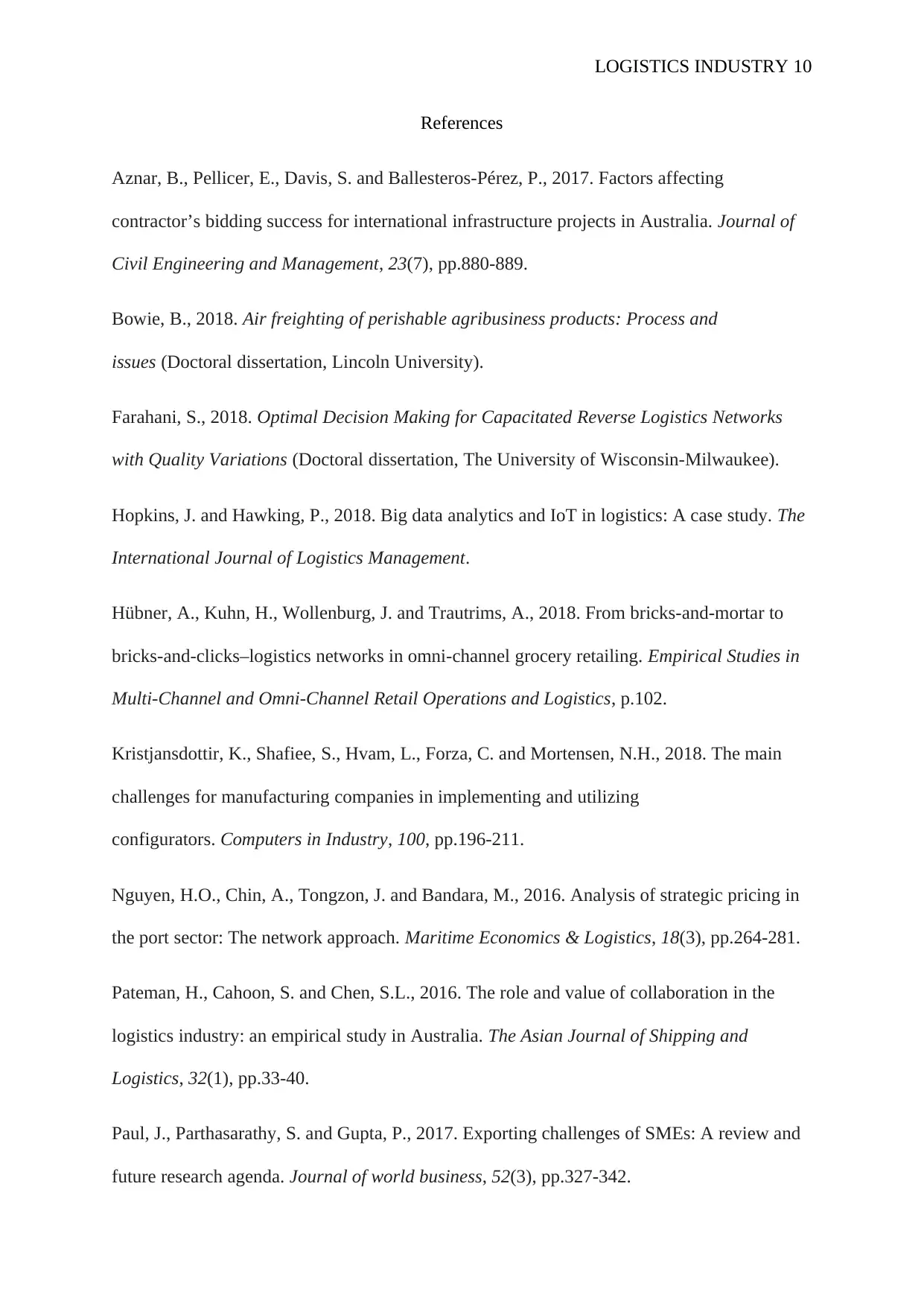
LOGISTICS INDUSTRY 10
References
Aznar, B., Pellicer, E., Davis, S. and Ballesteros-Pérez, P., 2017. Factors affecting
contractor’s bidding success for international infrastructure projects in Australia. Journal of
Civil Engineering and Management, 23(7), pp.880-889.
Bowie, B., 2018. Air freighting of perishable agribusiness products: Process and
issues (Doctoral dissertation, Lincoln University).
Farahani, S., 2018. Optimal Decision Making for Capacitated Reverse Logistics Networks
with Quality Variations (Doctoral dissertation, The University of Wisconsin-Milwaukee).
Hopkins, J. and Hawking, P., 2018. Big data analytics and IoT in logistics: A case study. The
International Journal of Logistics Management.
Hübner, A., Kuhn, H., Wollenburg, J. and Trautrims, A., 2018. From bricks-and-mortar to
bricks-and-clicks–logistics networks in omni-channel grocery retailing. Empirical Studies in
Multi-Channel and Omni-Channel Retail Operations and Logistics, p.102.
Kristjansdottir, K., Shafiee, S., Hvam, L., Forza, C. and Mortensen, N.H., 2018. The main
challenges for manufacturing companies in implementing and utilizing
configurators. Computers in Industry, 100, pp.196-211.
Nguyen, H.O., Chin, A., Tongzon, J. and Bandara, M., 2016. Analysis of strategic pricing in
the port sector: The network approach. Maritime Economics & Logistics, 18(3), pp.264-281.
Pateman, H., Cahoon, S. and Chen, S.L., 2016. The role and value of collaboration in the
logistics industry: an empirical study in Australia. The Asian Journal of Shipping and
Logistics, 32(1), pp.33-40.
Paul, J., Parthasarathy, S. and Gupta, P., 2017. Exporting challenges of SMEs: A review and
future research agenda. Journal of world business, 52(3), pp.327-342.
References
Aznar, B., Pellicer, E., Davis, S. and Ballesteros-Pérez, P., 2017. Factors affecting
contractor’s bidding success for international infrastructure projects in Australia. Journal of
Civil Engineering and Management, 23(7), pp.880-889.
Bowie, B., 2018. Air freighting of perishable agribusiness products: Process and
issues (Doctoral dissertation, Lincoln University).
Farahani, S., 2018. Optimal Decision Making for Capacitated Reverse Logistics Networks
with Quality Variations (Doctoral dissertation, The University of Wisconsin-Milwaukee).
Hopkins, J. and Hawking, P., 2018. Big data analytics and IoT in logistics: A case study. The
International Journal of Logistics Management.
Hübner, A., Kuhn, H., Wollenburg, J. and Trautrims, A., 2018. From bricks-and-mortar to
bricks-and-clicks–logistics networks in omni-channel grocery retailing. Empirical Studies in
Multi-Channel and Omni-Channel Retail Operations and Logistics, p.102.
Kristjansdottir, K., Shafiee, S., Hvam, L., Forza, C. and Mortensen, N.H., 2018. The main
challenges for manufacturing companies in implementing and utilizing
configurators. Computers in Industry, 100, pp.196-211.
Nguyen, H.O., Chin, A., Tongzon, J. and Bandara, M., 2016. Analysis of strategic pricing in
the port sector: The network approach. Maritime Economics & Logistics, 18(3), pp.264-281.
Pateman, H., Cahoon, S. and Chen, S.L., 2016. The role and value of collaboration in the
logistics industry: an empirical study in Australia. The Asian Journal of Shipping and
Logistics, 32(1), pp.33-40.
Paul, J., Parthasarathy, S. and Gupta, P., 2017. Exporting challenges of SMEs: A review and
future research agenda. Journal of world business, 52(3), pp.327-342.
Paraphrase This Document
Need a fresh take? Get an instant paraphrase of this document with our AI Paraphraser
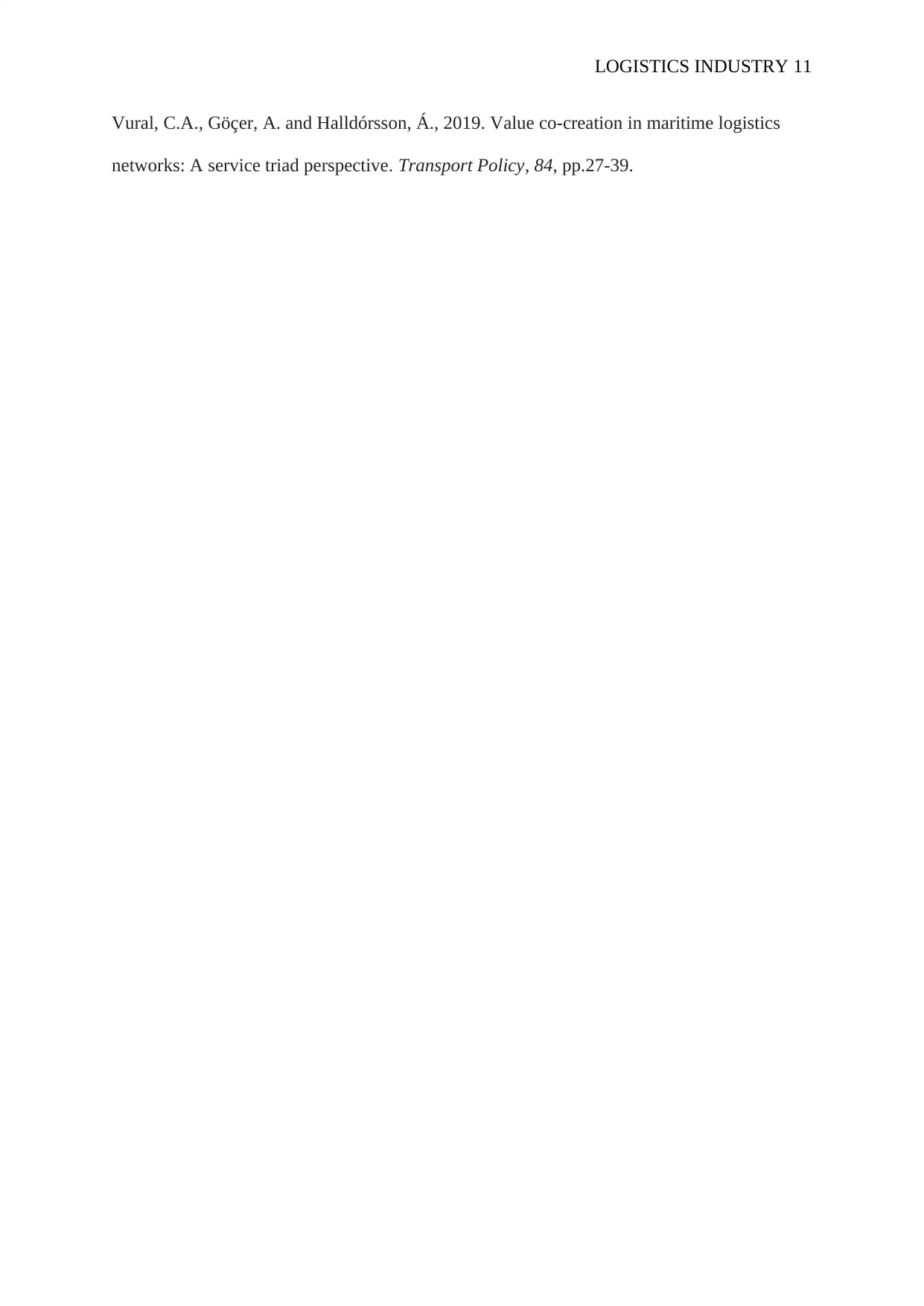
LOGISTICS INDUSTRY 11
Vural, C.A., Göçer, A. and Halldórsson, Á., 2019. Value co-creation in maritime logistics
networks: A service triad perspective. Transport Policy, 84, pp.27-39.
Vural, C.A., Göçer, A. and Halldórsson, Á., 2019. Value co-creation in maritime logistics
networks: A service triad perspective. Transport Policy, 84, pp.27-39.
1 out of 11
Related Documents
Your All-in-One AI-Powered Toolkit for Academic Success.
+13062052269
info@desklib.com
Available 24*7 on WhatsApp / Email
![[object Object]](/_next/static/media/star-bottom.7253800d.svg)
Unlock your academic potential
Copyright © 2020–2025 A2Z Services. All Rights Reserved. Developed and managed by ZUCOL.





